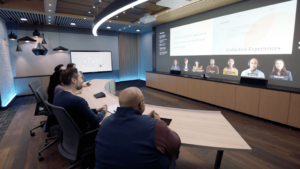 [Editor’s note: This content was written to highlight a particular event or moment in time. Although that moment has passed, we’re republishing it here so you can see what our thinking and experience was like at the time.]
[Editor’s note: This content was written to highlight a particular event or moment in time. Although that moment has passed, we’re republishing it here so you can see what our thinking and experience was like at the time.]
How do you connect people across 48 countries for a global team meeting? Nathalie D’Hers’ team is one of the most far-flung at Microsoft—the 500-plus people in her organization are scattered across the globe, with at least one employee working in nearly every major Microsoft office.
“With an organization so geographically distributed, it’s hard to keep everyone aligned and on the same page, and to create a sense of community unless you get together at least once a year,” says D’Hers, corporate vice president for Employee Experience, the team behind delivering the company’s productivity tools and services to company employees. “That’s why we’ve always had an in-person meeting once a year.”
That thinking shifted three years ago, when D’Hers didn’t have budget to fly everyone to a central location. She didn’t want to lose the substantial benefit of bringing everyone together, so she decided to get creative.
“My team thought I was a little crazy when I suggested we have an 18-hour continuous virtual meeting to ensure that we could span all time zones,” D’Hers says. “They wanted to know how we could pull something like that off. I felt, as a technology company if anyone could do it, we could.”
After much preparation and logistics work, her team successfully delivered and participated in an 18-hour rally that brought the team together “in a rousingly successful manner,” D’Hers says.
It was so successful, in fact, that she decided to try it again this year—all 18 hours of it.
“It worked—we did it again,” says D’Hers, still recovering from a meeting that started at 11 p.m. Pacific Time on Monday, February 25th, and that didn’t end for another 18 hours, at 5 p.m. Pacific Time the next day. The meeting was broken into four-hour increments due to current product design. “We were able to deliver greater clarity for everyone, as far as what we want to accomplish over the next year, and we really saw the team come together.”
What’s the secret behind the success?
D’Hers says it was how the technology faded into the background, so much so that employees started to forget that it was there—partly because they literally got caught up in the story of the meeting.

That on its own wasn’t enough to make the meeting successful, however.
“We also knew we had to do something to draw people in—they were intrigued last time because we had never held a virtual meeting before, it was new and they wanted to see if it would work,” she says. “The newness factor wasn’t going to work this time, so we had to do something different.”
She did it by asking everyone on the team to help tell the definitive story of her team.
“We assigned teams of people from each of the time zones to get together in specific Teams channels on Microsoft 365 to tell their chapter of our overall story,” D’Hers says. “It was up to them to figure out how their part should go.”
Following the sun, each collection of storytellers reported out their chapter in time-zone order, something that generated a lot of energy in all the offices that the team has scattered around the world. “At the end of the meeting, we wove all of those chapters together into one big story about our team, and I wrapped up the meeting with an epilogue that I used to tie everything together,” D’Hers says. “One of the most fun things I got to do was read the story back to the team at the end of the meeting.”
D’Hers’ intention was to create clarity and alignment around what the group is trying to accomplish while also fostering a sense of community and team spirit.
“I was incredibly impressed by how the story came together in a very seamless way and the way it highlighted the amazing diversity and talent we have across the organization,” she says.
As for the story, it was a tale that started in Australia and New Zealand, zipped to Japan, stopped in China, zoomed to Singapore, travelled to India, made several stops in Africa, Asia, and Europe, before heading to South America, Canada, and finally to the United States and company headquarters in Redmond, Washington. To make things even more interesting, each team of storytellers could only see what the location before them had written. It wasn’t until the end of the meeting that everyone was able to hear how their chapter fit into the larger story.
“The sun never sets on our team,” the story starts out saying, weaving in the tale of individual employee experiences, group accomplishments, and enthusiastic team building. D’Hers wrote in the epilogue that she feels an immense sense of pride and gratitude for how much heart and effort her team poured into the meeting.
The best technology fades into the background.
The experience of running this year’s virtual meeting was better than the first one because the company’s large meeting technology is much better.
The new capabilities were not so much for the people attending the meeting—most of the improvements in the product were aimed at the people running the event itself. It worked so much better this time around while being seamless to the audience.
The team also got an important assist from outside the company.
One critical aspect that also made this 18-hour event such a great success was the help we got from a third-party real-time monitoring solution. It gave us the ability to have live monitoring of video buffering, see how much bandwidth viewers were using, and also track how many people were attending the meeting at any one time.
Years ago, the company’s large meeting offering was Skype Meeting Broadcast, a one-way feed that had to be hacked to allow teams to report in live from around the world. Since then, Microsoft has moved to the new live events capability that is part of Microsoft 365, a threaded large meeting offering that includes Microsoft Teams, Viva Engage, and Microsoft Stream.
“We used all three platforms to help us run the meeting,” says Fred Van Camp, a senior IT service manager also on D’Hers’ team in Microsoft Digital. “Viva Engage allowed our viewers to talk with each other or the presenter using Viva’s persistent chat capability.”
Another big improvement this time around was how well the live events technology worked with Microsoft Teams. For example, if a viewer asked an ad hoc question during the live broadcast of the meeting, the production team used a custom-made configuration to connect her or him to the meeting via a Teams call using a studio managed encoder.
Everything worked better together.
When it was time to start bringing in teams from places like Australia, the Netherlands, and Brazil, it was easy as making a call. “It was pretty straightforward, we were just making normal Teams calls,” Van Camp says. “We just called them, and our video production team seamlessly patched them into the webcast.”
It was about the technology doing its job.
“We wanted to see the technology disappear,” Van Camp says. “The whole show flow was built in such a way that the technology just faded into the background. It was very cool to see it all come together.”
Another big difference this time is that viewers could view and engage in the meeting from mobile devices, either on their mobile device or in browser.
And for the people that missed any part of the 18-hour event, it was easy for them to catch up with the recording of the event—after the event ended, the broadcast stream was automatically uploaded as a video on demand on Microsoft Stream.
Van Camp added, “The event recording in Stream made it easy for everyone to search for keywords in the auto populated transcript so they could quickly find the moments most important to them.”
D’Hers says her team’s experience will be fed back into the product groups so that it can learn from the unique way her team is meeting. “We leverage our own technology internally as much as possible,” she says. “We have a responsibility to identify further product opportunities, and to relay those back to the product groups.”
The product group appreciates how Microsoft Digital is putting the live event technology through its paces.
Weaving in the human element
Switching to the live events capability made it much easier to generate a sense of community during the global meeting.
We were focused on stimulating conversation on Viva Engage. We steered as much of the conversation into that feed so we could hear from as many people as possible. That really helped build a sense of, ”we’re in this together.”
Many great conversations spun up in Viva Engage, including several on the collective story that the team wrote together. “And those conversations won’t end now that the meeting is over,” she says. “The idea was to get people to talking with teammates they don’t usually talk to, and we saw lots of people making new friends and finding new people to collaborate with.”
For her part, D’Hers’ walks away from the virtual meeting with a feeling of accomplishment.
“We still want to have in-person meetings—you get a lot of value out of meeting face-to-face,” she says. “But I also like what we were able to do virtually. I feel like we were successful in landing our all up vision for the group and building the sense of connection that we need to have to be successful.”
The meeting worked so well because the team brought energy and enthusiasm. “We didn’t just get through it, we made it very special,” D’Hers says. “I think people walked away with a sense of pride and excitement.”

- Discover corporate video at Microsoft gets a big upgrade thanks to the modern Microsoft Stream experience.
- Explore how Microsoft’s senior leaders bring employees together during COVID-19.
- Unpack how Microsoft uses integrated live event capabilities in Microsoft 365 to create, run, and share events of different types, audiences, and budgets.





